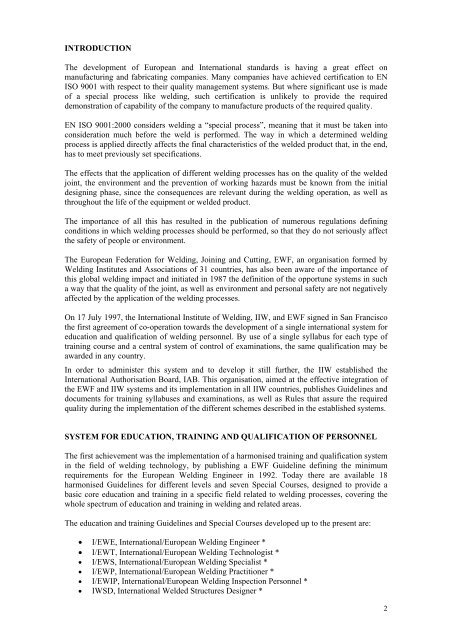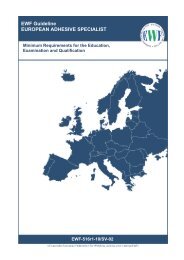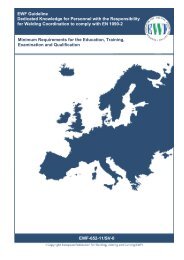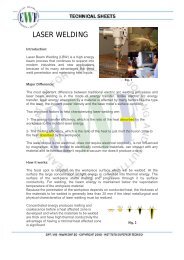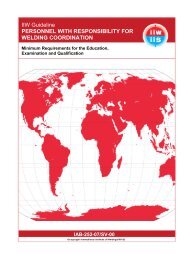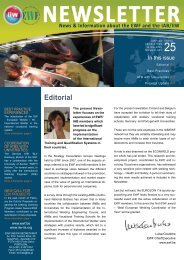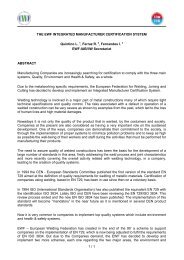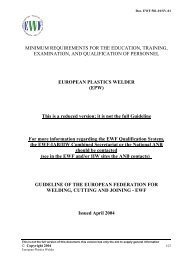International welding qualification and certification systems - EWF
International welding qualification and certification systems - EWF
International welding qualification and certification systems - EWF
Create successful ePaper yourself
Turn your PDF publications into a flip-book with our unique Google optimized e-Paper software.
INTRODUCTION<br />
The development of European <strong>and</strong> <strong>International</strong> st<strong>and</strong>ards is having a great effect on<br />
manufacturing <strong>and</strong> fabricating companies. Many companies have achieved <strong>certification</strong> to EN<br />
ISO 9001 with respect to their quality management <strong>systems</strong>. But where significant use is made<br />
of a special process like <strong>welding</strong>, such <strong>certification</strong> is unlikely to provide the required<br />
demonstration of capability of the company to manufacture products of the required quality.<br />
EN ISO 9001:2000 considers <strong>welding</strong> a “special process”, meaning that it must be taken into<br />
consideration much before the weld is performed. The way in which a determined <strong>welding</strong><br />
process is applied directly affects the final characteristics of the welded product that, in the end,<br />
has to meet previously set specifications.<br />
The effects that the application of different <strong>welding</strong> processes has on the quality of the welded<br />
joint, the environment <strong>and</strong> the prevention of working hazards must be known from the initial<br />
designing phase, since the consequences are relevant during the <strong>welding</strong> operation, as well as<br />
throughout the life of the equipment or welded product.<br />
The importance of all this has resulted in the publication of numerous regulations defining<br />
conditions in which <strong>welding</strong> processes should be performed, so that they do not seriously affect<br />
the safety of people or environment.<br />
The European Federation for Welding, Joining <strong>and</strong> Cutting, <strong>EWF</strong>, an organisation formed by<br />
Welding Institutes <strong>and</strong> Associations of 31 countries, has also been aware of the importance of<br />
this global <strong>welding</strong> impact <strong>and</strong> initiated in 1987 the definition of the opportune <strong>systems</strong> in such<br />
a way that the quality of the joint, as well as environment <strong>and</strong> personal safety are not negatively<br />
affected by the application of the <strong>welding</strong> processes.<br />
On 17 July 1997, the <strong>International</strong> Institute of Welding, IIW, <strong>and</strong> <strong>EWF</strong> signed in San Francisco<br />
the first agreement of co-operation towards the development of a single international system for<br />
education <strong>and</strong> <strong>qualification</strong> of <strong>welding</strong> personnel. By use of a single syllabus for each type of<br />
training course <strong>and</strong> a central system of control of examinations, the same <strong>qualification</strong> may be<br />
awarded in any country.<br />
In order to administer this system <strong>and</strong> to develop it still further, the IIW established the<br />
<strong>International</strong> Authorisation Board, IAB. This organisation, aimed at the effective integration of<br />
the <strong>EWF</strong> <strong>and</strong> IIW <strong>systems</strong> <strong>and</strong> its implementation in all IIW countries, publishes Guidelines <strong>and</strong><br />
documents for training syllabuses <strong>and</strong> examinations, as well as Rules that assure the required<br />
quality during the implementation of the different schemes described in the established <strong>systems</strong>.<br />
SYSTEM FOR EDUCATION, TRAINING AND QUALIFICATION OF PERSONNEL<br />
The first achievement was the implementation of a harmonised training <strong>and</strong> <strong>qualification</strong> system<br />
in the field of <strong>welding</strong> technology, by publishing a <strong>EWF</strong> Guideline defining the minimum<br />
requirements for the European Welding Engineer in 1992. Today there are available 18<br />
harmonised Guidelines for different levels <strong>and</strong> seven Special Courses, designed to provide a<br />
basic core education <strong>and</strong> training in a specific field related to <strong>welding</strong> processes, covering the<br />
whole spectrum of education <strong>and</strong> training in <strong>welding</strong> <strong>and</strong> related areas.<br />
The education <strong>and</strong> training Guidelines <strong>and</strong> Special Courses developed up to the present are:<br />
• I/EWE, <strong>International</strong>/European Welding Engineer *<br />
• I/EWT, <strong>International</strong>/European Welding Technologist *<br />
• I/EWS, <strong>International</strong>/European Welding Specialist *<br />
• I/EWP, <strong>International</strong>/European Welding Practitioner *<br />
• I/EWIP, <strong>International</strong>/European Welding Inspection Personnel *<br />
• IWSD, <strong>International</strong> Welded Structures Designer *<br />
2


